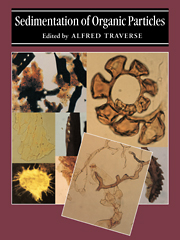Book contents
- Frontmatter
- Contents
- Editor's preface
- List of contributors
- I Introduction
- II Studies of palynosedimentation in modern environments
- III Reconstruction of late Cenozoic vegetation and sedimentary environments from palynological data
- IV Application of data on palynosedimentation to solution of geological problems
- 16 Palynology of sedimentary cycles
- 17 Particulate organic matter, maceral facies models, and applications to sequence stratigraphy
- 18 Association of palynomorphs and palynodebris with depositional environments: quantitative approaches
- 19 A quantitative approach to Triassic palynology: the Lettenkeuper of the Germanic Basin as an example
- 20 Palynomorph concentration in studies of Paleogene nonmarine depositional environments of Wyoming
- 21 Multivariate analyses of palynomorph data as a key to depositional environments of Upper Cretaceous and Paleogene coal-bearing rocks of the western United States
- 22 Relationships between depositional environments and changes in palynofloras across the K/T boundary interval
- 23 Sedimentation of palynomorphs in rocks of pre-Devonian age
- V Appendix
- Index
18 - Association of palynomorphs and palynodebris with depositional environments: quantitative approaches
Published online by Cambridge University Press: 06 January 2010
- Frontmatter
- Contents
- Editor's preface
- List of contributors
- I Introduction
- II Studies of palynosedimentation in modern environments
- III Reconstruction of late Cenozoic vegetation and sedimentary environments from palynological data
- IV Application of data on palynosedimentation to solution of geological problems
- 16 Palynology of sedimentary cycles
- 17 Particulate organic matter, maceral facies models, and applications to sequence stratigraphy
- 18 Association of palynomorphs and palynodebris with depositional environments: quantitative approaches
- 19 A quantitative approach to Triassic palynology: the Lettenkeuper of the Germanic Basin as an example
- 20 Palynomorph concentration in studies of Paleogene nonmarine depositional environments of Wyoming
- 21 Multivariate analyses of palynomorph data as a key to depositional environments of Upper Cretaceous and Paleogene coal-bearing rocks of the western United States
- 22 Relationships between depositional environments and changes in palynofloras across the K/T boundary interval
- 23 Sedimentation of palynomorphs in rocks of pre-Devonian age
- V Appendix
- Index
Summary
Introduction
During the past few years there has been considerable interest in the way in which the composition of the acid resistant organic content of sedimentary rocks can be used to aid the interpretation of depositional environments. However, much of the published work has not involved fully comprehensive analyses. There has been a tendency to concentrate either on the distribution of palynomorphs at the expense of less well characterized phytoclasts, or on the shape and composition of the particulate detritus recovered, with scant attention being paid to the environmental implications of the presence of individual species of microfossils. As a result, much information of potential value to the aims of palynofacies analysis has been lost. In addition, comparatively little use has been made of numerical methods in analyzing and interpreting the data. Multivariate methods, which reduce the dimensionality of the data, can bring the most important trends to the fore and provide a quantitative basis for assessing these in the light of lithology and depositional environment. They also provide a graphical means of presenting the results much more effectively than through written descriptions alone.
In this chapter we review a variety of approaches that may be taken to analyze palynofacies and depositional environments, concentrating on the use of quantitative and multivariate methods. In order to demonstrate the usefulness of these techniques, we re-analyze a number of previously published sets of palynological and palynofacies data with principal components and cluster analyses, using the computer program MVSP (Kovach, 1990). We also discuss approaches other authors have taken in applying numerical methods to palynofacies studies in order to demonstrate the range of techniques available.
- Type
- Chapter
- Information
- Sedimentation of Organic Particles , pp. 391 - 408Publisher: Cambridge University PressPrint publication year: 1994
- 8
- Cited by



